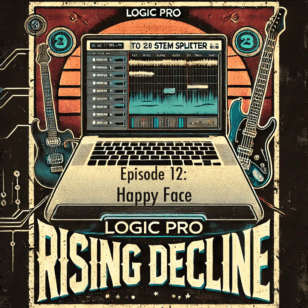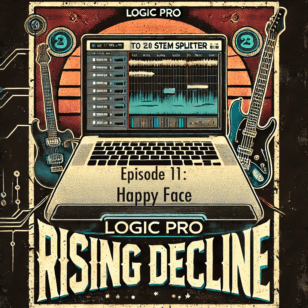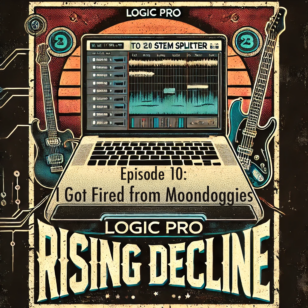As I finish my third year as Director of Technology at Hillbrook School, I find myself thinking of a three year old human. Let’s personify my tenure here as a toddler. What significant milestones are there for a three year old? Well, they ask lots of questions. They tell stories. They can walk forward and backward easily. And I can’t help but notice similarities with my time as a senior administrator at Hillbrook. I find myself questioning why certain IT systems are in place, and how we can improve them. My presentations at conferences are increasingly becoming more about telling the story of Hillbrook’s learning spaces and technology integration. And, I find myself finding a “solution,” only to discover that things are often much more complicated than I initially intended, moving forward and backward with initiatives and projects.
Here are five things I focused on this past year:
- Design the Hub experience.
- How might we reimagine the Tech Squad as a way to develop digital leaders at Hillbrook?
- How might we better share the work of the Hillbrook CTE to promote collaborative teaching and teacher development?
- How might we authentically integrate coding and robotics into our program in a way that’s ground up and not top down?
- How can portfolios serve as a catalyst for strengthening our efforts to better individualize our program?
Design the Hub experience.
As I write this, I sit by an oak tree facing Ken’s art room. The science classrooms are to my right down a small ramp, there is a parking lot in front of me with six spots, and the tower with the barn owls on the third floor rises above me to the left. It’s fortuitous that I’m reflecting on The Hub as I sit here. The Hub will be a space where art, science, engineering, and technology come together, both programmatically and physically. This past month, the board approved the funding and construction of The Hub with hopes of breaking ground in the fall of 2018. And while I won’t be outside with a shovel breaking ground myself, I have taken several strategic steps towards moving this project along.
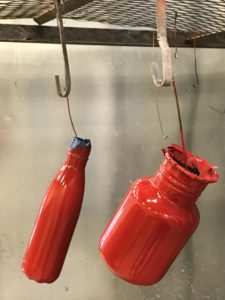 Ken Hay, co-lead of The Hub project, and I have memberships to the TechShop in downtown San Jose. My goal with this membership to get hands-on experience with a wide variety of “making” tools to better inform upcoming decisions about what to put inside The Hub once it’s built, as well as learn lessons about space. I’ve taken classes on powder coating, ShopBot (CNC wood router), long arm quilting, and 3d printing, to name a few. As we give feedback on blueprints, I realize just how much time at the TechShop informs my opinion. With an eye towards noise, dust, and movement, I’m better able to visualize how we might actually use the space one it’s built. As we move from conceptual plans to blueprints, Ken and I will continue to help shape the vision of how we use this new space.
Ken Hay, co-lead of The Hub project, and I have memberships to the TechShop in downtown San Jose. My goal with this membership to get hands-on experience with a wide variety of “making” tools to better inform upcoming decisions about what to put inside The Hub once it’s built, as well as learn lessons about space. I’ve taken classes on powder coating, ShopBot (CNC wood router), long arm quilting, and 3d printing, to name a few. As we give feedback on blueprints, I realize just how much time at the TechShop informs my opinion. With an eye towards noise, dust, and movement, I’m better able to visualize how we might actually use the space one it’s built. As we move from conceptual plans to blueprints, Ken and I will continue to help shape the vision of how we use this new space.
Two other projects–the 8th grade capstones and 5th grade Maker Faire projects–have also provided perspectives that will inform Hub designs. Both projects remind us that student choice and engagement continue to be at the center of everything we do at Hillbrook. Our new space, The Hub, will need to be equally student-focused, able to accommodate a variety of student groupings and needs.
Colleen Schilly and Erin Cohn from Leadership&Design have led a committee on reimagining the Hillbrook schedule. I’ve participated on this committee with an eye towards how The Hub might influence the creation of the new schedule. A highlight of this experience was shadowing a second grader through an entire school day. I was expecting to find friction points throughout the whole day and come to the committee with a list of things we need to fix. I was pleasantly surprised to find that the student experience at Hillbrook is extraordinary. Transitions felt natural, lessons felt like they were the right length, and students had opportunities to talk, snack, and play. Our committee visited Design 39 and High Tech High, and I left with another unexpected take away–our school is doing extraordinary things. Wrapping up the first half of the schedule committee’s work, I realize that we are teed up for an opportunity to rethink how we use time at Hillbrook. At a time where the Scott Center for Social Entrepreneurship and The Hub are at their inception, this is an exceptionally exciting time to continue this work.
How might we reimagine the Tech Squad as a way to develop digital leaders at Hillbrook?
A student group, the iPad Doctors, grew out of two needs: lead tour groups to explain how this new-fangled iPad might be used in school (circa 2011), and help troubleshoot usage of this new technology. Well, both needs are significantly less.
So, how might we develop digital leaders at Hillbrook? Last year, we reimagined the iPad Doctor program to be the Tech Squad. But without a true need, this student group felt like a fun, non-critical group. To be honest, I’ve really struggled with finding a meaningful task/project/vision for the Tech Squad. Part of that failure might be that we only meet every six school days during lunch for 25 minutes. Part of that failure might be that we don’t give public tours, and that troubleshooting iPads has become much simpler. Part of it might be a lack of imagination on my part. There have been a couple huge successes this year, however.
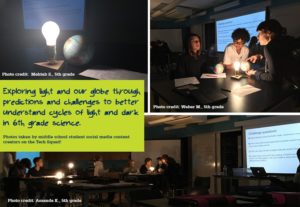 Erin Schwartz, our communications director, created grade-level Twitter accounts for all ten grades at Hillbrook, so that families could follow @hillbrook5th for grade-specific news, and @hillbrookschool for school-wide news. The initial plan was bold–give ownership of grade-level Twitter to Tech Squad members. This just never took off, though. Students weren’t interested in tweeting daily, and the level of oversight we initially needed was too difficult to manage. So we waited until there was a need. And that need came on January 10, 2017 when Erin wanted to photograph 6th graders doing an epic experiment around light, but was double booked. The solution? Tech squad members Mehtab, Weber, and Amanda photographed the experiments! This was such a simple and powerful solution. Tech Squad member photos were even featured in the January 11 Hillbrook Happenings newsletter.
Erin Schwartz, our communications director, created grade-level Twitter accounts for all ten grades at Hillbrook, so that families could follow @hillbrook5th for grade-specific news, and @hillbrookschool for school-wide news. The initial plan was bold–give ownership of grade-level Twitter to Tech Squad members. This just never took off, though. Students weren’t interested in tweeting daily, and the level of oversight we initially needed was too difficult to manage. So we waited until there was a need. And that need came on January 10, 2017 when Erin wanted to photograph 6th graders doing an epic experiment around light, but was double booked. The solution? Tech squad members Mehtab, Weber, and Amanda photographed the experiments! This was such a simple and powerful solution. Tech Squad member photos were even featured in the January 11 Hillbrook Happenings newsletter.
Another goal I had was to work with members of the Tech Squad to facilitate digital citizenship lessons with lower school students. Middle school students just weren’t interested in this, though. I found it took a lot of time to try and coordinate with very little interest. I haven’t figured out how to leverage the expertise of the Tech Squad with lower school students, but I still feel like it’s a great opportunity for them to reach beyond themselves to make a difference.
A surprising win for the Tech Squad was Vidigami, a photo sharing platform we adopted this past year. The power of Vidigami is the ability to tag student and faculty names to faces in photos. This takes a lot of work, but is fantastic when it’s complete. As it turns out, middle school students love looking at photos of each other. We spent several Tech Squad meetings throughout the year tagging faces in photos on Vidigami, and I’m happy to share that nearly every photo has nearly every face tagged in it. The result is that parents can open the app/website and automatically see all the photos of their kid(s)!
How might we better share the work of the Hillbrook CTE to promote collaborative teaching and teacher development?
Ilsa and I have been creating and sharing content for the Hillbrook CTE. This past year, we added blog posts and podcast episodes to hillbrookcte.org. Using @hillbrookcte, we shared out faculty and staff presentations on Twitter, in addition to sharing random Twittery education stuff.
The goal of the CTE is inward facing and outward facing. We found that sharing content related to conferences and presentations was great, but noticed that Hillbrook faculty weren’t engaging with the CTE on Twitter. So, Ilsa printed out all the @hillbrookcte tweets on paper, and stapled them up to the faculty lunchroom bulletin board. Teachers didn’t begin tweeting more, but we both had some great conversations around both the work of the CTE and the presentations of faculty and staff.
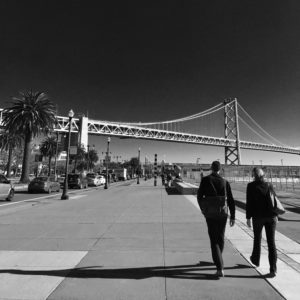 A tangential, but important, project this year was the IDEO/MISBO cohort we participated in. Initially designed to reimagine the independent school financial model, it quickly became a place for our school to talk with key people at the Mount Vernon Institute for Innovation and at IDEO. Conversations with Bo Adams and Miki Heller proved insanely helpful as we looked at our model for social accounts.
A tangential, but important, project this year was the IDEO/MISBO cohort we participated in. Initially designed to reimagine the independent school financial model, it quickly became a place for our school to talk with key people at the Mount Vernon Institute for Innovation and at IDEO. Conversations with Bo Adams and Miki Heller proved insanely helpful as we looked at our model for social accounts.
The last big win for the Hillbrook CTE this school year was our partnership with CUE to continue telling our Reimagining Classrooms story through CUE’s BOLD Symposium. This conference was first of its kind, deeply diving into classroom design and lesson design. I worked with Jon Corippo, CUE’s Chief Innovation Officer, and BOLD Director Lindsay Blass to help shape the conference.
How might we authentically integrate coding and robotics into our program in a way that’s ground up and not top down?
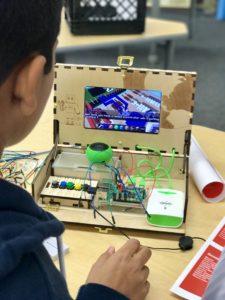 This story has a surprising twist. Let’s start with the ending, and work our way back a couple years. Last week, Apple announced that Swift Playgrounds, its educational coding app for iPad, will offer an exciting new way to learn to code using robots, drones and musical instruments. We’ve been coding robots and drones for the last two year, mostly during Week of Code, using apps like Tickle and Tynker. Students worked with block-based programming to give simple commands to robots like: “Take off, set maximum height to 2m, fly forward for 4.2 sec, turn right 30º, fly forward for 1.2 sec, land.” This has been a powerful way to engage students with computational thinking and coding. This recent announcement by Apple means that we can now use Swift, the coding language used to develop iOS apps, to control these robots. We are poised to quickly move from the introductory block-based coding to the advanced Swift coding. We already have the robots and the activities; we can simply scaffold students as they’re ready to move into text-based coding. It’s an incredibly exciting time.
This story has a surprising twist. Let’s start with the ending, and work our way back a couple years. Last week, Apple announced that Swift Playgrounds, its educational coding app for iPad, will offer an exciting new way to learn to code using robots, drones and musical instruments. We’ve been coding robots and drones for the last two year, mostly during Week of Code, using apps like Tickle and Tynker. Students worked with block-based programming to give simple commands to robots like: “Take off, set maximum height to 2m, fly forward for 4.2 sec, turn right 30º, fly forward for 1.2 sec, land.” This has been a powerful way to engage students with computational thinking and coding. This recent announcement by Apple means that we can now use Swift, the coding language used to develop iOS apps, to control these robots. We are poised to quickly move from the introductory block-based coding to the advanced Swift coding. We already have the robots and the activities; we can simply scaffold students as they’re ready to move into text-based coding. It’s an incredibly exciting time.
Rewind to the summer of 2016 when Apple announced Swift Playgrounds (Playgrounds is the iPad app). I spoke with Chris Cabrera and Shea Ellerson, and we immediately made plans to integrate coding into the math and science curricula. Chris spent time students coding with javascript on Khan Academy, but it wasn’t quite the right tool for him. Swift Playgrounds made coding more engaging (aka fun), it was iPad-friendly, it used a coding language that was simpler to understand, and it used a language that students could use to build actual iOS app.
I am incredibly proud of the math team for quickly starting this. It is a perfect example of The Hillbrook Way–ask, start, collaborate, show. Despite Swift Playgrounds being a brand new iPad app (and nobody knowing how to use that language), the math team started using it. Alongside students, they learned how to code with Swift. Not surprisingly, we were one of the first schools to use this app. Throughout the year, the three of us have spoken with teams at Apple several times, giving feedback about how our students use the app. I realized just how cutting edge our math team was when Wendy Lee from the San Francisco Chronicle called to talk to us about how we use Swift Playgrounds. Unfortunately, she wanted to come down on the last day of school to interview us and take photos, so we didn’t make it in the paper, but it’s a reminder that starting something, even when we don’t know how it’s going to turn out, is a powerful way to transform learning.
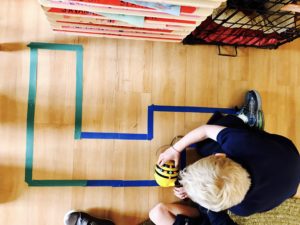
Week of Code, the Hillbrook version of Hour of code, was a huge success this year. At the heart or this week was a two-hour coding experience for lower school and middle school students, where they chose two different coding stations. Activities ranged from the ever-popular Hillbrook Air Corps to the Sphero Obstacle Course. Another highlight from this week was the 8th grade field trip to Google, where students met with the Toontastic app team, and heard about the complexities of coding a real app.
One other project this year was a huge success this year. 8th grade geometry students worked with Robert Sears and Shea Ellerson to create Archimedean solids. They designed these by writing code in Python. A particular challenge this year was to figure out how each face of the Archimedean solid would connect to the others. Once they designed each face, they used the laser cutter to cut the outline and etch the inside of each face, and then they assembled the Archimedean solid. As though this wasn’t impressive enough, some students used copper tape and LEDs to create a simple circuit and light up their Archimedean solid.
How can portfolios serve as a catalyst for strengthening our efforts to better individualize our program?
Portfolios are tricky. There is not a consensus around what a portfolio is, let alone what should go into it. Three years ago, I began the work of finding a digital platform for student work. I naively thought that if we found the right platform, everyone would happily begin using it. We’ve tried to capture student work and student learning in a variety of digital and analog ways. As it turns out, there is not a simple solution.
So, like a three year old, I find myself moving forward and backward on this goal. Our school promises to meet the individual needs of each student. I found that portfolios also need to meet the individual needs of each teacher.
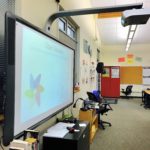
The big success of portfolios this year was working with Elisabeth Crabtree and Mei Chen to implement Sesame as a teacher-curated formative assessment tool. Sesame allows teachers, students, and classmates to capture a variety of media–text, photo, video, and audio. It makes sense to me that a mus
ic teacher and Mandarin teacher are excited about capturing audio. Not surprisingly, Elisabeth and Mei have been loving the Sesame platform. More importantly, it’s been a powerful way to track student progress in subjects that historically struggle with capturing authentic assessment. Next year, we will continue using Sesame to capture student work. I am hopeful that students will begin using this platform to capture their own work in other areas.
On a related note, Elisabeth and I presented on process portfolios at the Fall CUE conference. I am proud of Elisabeth for taking a risk and being a presenter at a major event, particularly in October when Sesame was still a new platform. This is another great example of The Hillbrook Way, where we ask, start, collaborate, and show.
Beyond Hillbrook
And now for a bit of a tangent to wrap things up. Perhaps it’s because I’m finally finishing this reflection in July and I just got back from the Apple Distinguished Educator Academy, but some of the most memorable parts of this past school year were presenting at conferences.
An education conference is a tricky thing to explain. Let me approach it by sharing two things that stick out in my memory after each and every conference.
The Presentation
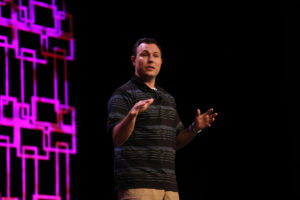
Being on stage sharing my work at Hillbrook is amazing. I love sharing, I love inspiring, I love reaching beyond myself to make a difference in the world. And being on a very big stage helps with that. (It’s also tons of fun!) This past year, I noticed a difference in the tone of my presentations. They shifted away from being my story and my thoughts to being more about the work we’re doing at Hillbrook. I remember talking with Aimee Giles during my first year at Hillbrook; she told me that my presentations in my first year would be more about me, and by the third year they would be more about the school. Well, Aimee was right. I shared about portfolios and learning spaces and coding and student-centered classrooms. I was able to authentically share our school’s work and it finally felt like our work.
The Conversations
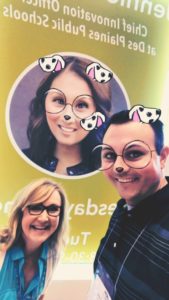
By far, my favorite part of conferences is having good conversations with good people. At Hillbrook, I’m the only Director of Technology, but at a conference, I am one of hundreds. Conferences are a place where I not only can have those conversations with people that have my same role, but I can spend time with friends that also want to change the world.
 Ken Hay, co-lead of The Hub project, and I have memberships to the TechShop in downtown San Jose. My goal with this membership to get hands-on experience with a wide variety of “making” tools to better inform upcoming decisions about what to put inside The Hub once it’s built, as well as learn lessons about space. I’ve taken classes on powder coating, ShopBot (CNC wood router), long arm quilting, and 3d printing, to name a few. As we give feedback on blueprints, I realize just how much time at the TechShop informs my opinion. With an eye towards noise, dust, and movement, I’m better able to visualize how we might actually use the space one it’s built. As we move from conceptual plans to blueprints, Ken and I will continue to help shape the vision of how we use this new space.
Ken Hay, co-lead of The Hub project, and I have memberships to the TechShop in downtown San Jose. My goal with this membership to get hands-on experience with a wide variety of “making” tools to better inform upcoming decisions about what to put inside The Hub once it’s built, as well as learn lessons about space. I’ve taken classes on powder coating, ShopBot (CNC wood router), long arm quilting, and 3d printing, to name a few. As we give feedback on blueprints, I realize just how much time at the TechShop informs my opinion. With an eye towards noise, dust, and movement, I’m better able to visualize how we might actually use the space one it’s built. As we move from conceptual plans to blueprints, Ken and I will continue to help shape the vision of how we use this new space. Erin Schwartz, our communications director, created grade-level Twitter accounts for all ten grades at Hillbrook, so that families could follow @hillbrook5th for grade-specific news, and @hillbrookschool for school-wide news. The initial plan was bold–give ownership of grade-level Twitter to Tech Squad members. This just never took off, though. Students weren’t interested in tweeting daily, and the level of oversight we initially needed was too difficult to manage. So we waited until there was a need. And that need came on January 10, 2017 when Erin wanted to photograph 6th graders doing an epic experiment around light, but was double booked. The solution? Tech squad members Mehtab, Weber, and Amanda photographed the experiments! This was such a simple and powerful solution. Tech Squad member photos were even featured in the January 11 Hillbrook Happenings newsletter.
Erin Schwartz, our communications director, created grade-level Twitter accounts for all ten grades at Hillbrook, so that families could follow @hillbrook5th for grade-specific news, and @hillbrookschool for school-wide news. The initial plan was bold–give ownership of grade-level Twitter to Tech Squad members. This just never took off, though. Students weren’t interested in tweeting daily, and the level of oversight we initially needed was too difficult to manage. So we waited until there was a need. And that need came on January 10, 2017 when Erin wanted to photograph 6th graders doing an epic experiment around light, but was double booked. The solution? Tech squad members Mehtab, Weber, and Amanda photographed the experiments! This was such a simple and powerful solution. Tech Squad member photos were even featured in the January 11 Hillbrook Happenings newsletter.





